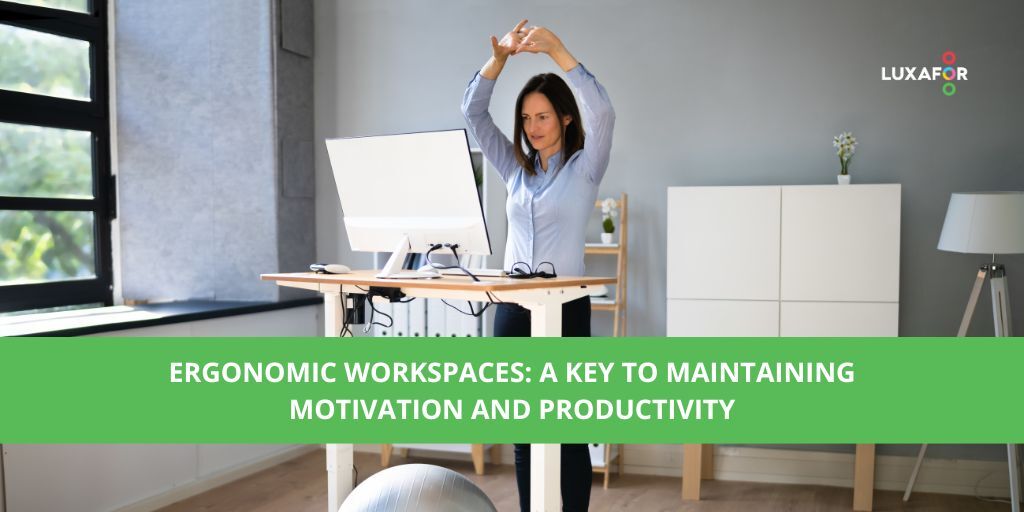Ergonomic Workspaces: A Key to Maintaining Motivation and Productivity
- Updated on: July 31, 2024
Last updated: 04.06.2024.
Ergonomic workspaces are designed to enhance comfort and efficiency, influencing both motivation and productivity positively. When employees are provided with an environment that supports their physical well-being, it can lead to a noticeable improvement in their ability to focus and perform. The principles of ergonomics emphasize the importance of a workspace that conforms to the user’s body, minimizing strain and reducing the likelihood of work-related injuries.
Motivation in the workplace is often tied to the surrounding environment. An ergonomic setup can contribute to a person’s willingness to engage with their tasks. This is due to the reduced physical discomfort and the psychological impact of working in a space that is thoughtfully designed. A well-considered ergonomic workspace not only supports the individual’s health but also demonstrates an employer’s commitment to their employees’ well-being, which can be a motivational factor in itself.
Productivity is closely linked to the layout and ergonomics of a workspace. When tools and equipment are within easy reach and at the appropriate height and angle, it minimizes unnecessary movement and allows for a smoother workflow. This efficient use of space and attention to detail cuts down on the time wasted adjusting to a suboptimal environment, allowing employees to allocate more energy to their actual work tasks. An ergonomic workspace is not a one-size-fits-all solution but rather a tailored approach that can adapt to the diverse needs of different users, ultimately fostering a productive and satisfying work experience.
Essential Ergonomic Principles for Productive Workspaces
Essential ergonomic principles are foundational to creating work environments that bolster health and productivity. They directly address issues such as discomfort, musculoskeletal disorders and fatigue, ensuring that workspaces are conducive to both wellbeing and efficiency.
Understanding Ergonomics and Its Impact on Health
Ergonomics involves the scientific study of people at work with the goal of improving the comfort and efficiency of workspaces. Proper ergonomic practices can prevent health problems, particularly musculoskeletal disorders, which are prevalent among those who work in static positions. An ergonomic workspace supports the user’s health by minimizing undesired physical strain and promoting a better working environment. It is essential to have a solid understanding of the meaning of ergonomics and its importance in promoting a healthy and safe work environment.
The Role of Good Posture in Enhancing Work Efficiency
Good posture is a critical aspect of an ergonomic workspace. Maintaining a natural spinal alignment reduces the risk of experiencing back pain and contributes to a sustainable working posture. Workstations should be designed so that they promote an upright and balanced posture, with computer monitors at eye-level and options for supportive seating that keeps the feet flat on the floor and the knees at a 90-degree angle.
Injury Prevention Through Ergonomic Workspace Design
Ergonomic workspace design is integral to injury prevention, particularly concerning eye strain and fatigue. Workspaces should be organized to ensure that:
- There is sufficient lighting to prevent eye strain.
- Monitors are at least an arm’s length away to reduce eye fatigue.
- Desks and office chairs are adjustable to fit different body sizes and shapes, providing necessary support.
- Equipment like keyboards and mice are positioned to keep wrists in a neutral position, avoiding strain.
Ultimately, an ergonomic workspace is an investment in your employee’s health, comfort, and overall productivity.
Optimizing the Workspace: Equipment and Adjustments
Creating an ergonomic workspace involves selecting the right equipment and making necessary adjustments to enhance comfort and efficiency. Proper ergonomic practices can prevent strain and injury, thereby maintaining an individual’s motivation and productivity.
Essential Ergonomic Equipment for Workspaces
An ideal workspace should include adjustable ergonomic office chairs with proper lumbar support to align the spine, desks that can be changed in height to accommodate sitting and standing postures, and keyboard trays that promote neutral wrist positioning. Including a footrest can also aid in reducing lower back pressure for individuals whose feet do not comfortably reach the floor.
- Chairs: Must be adjustable and offer adequate lumbar support
- Desks: Should allow for height adjustment
- Keyboard Trays: Need to ensure wrists remain in a neutral position
- Footrests: Beneficial for users whose feet do not rest flat on the ground
Proper Adjustment of Chairs, Desks, and Monitors
Adjusting the workspace for comfort and efficiency is vital. Chairs should be set so that feet are flat on the floor or on a footrest, with knees at a 90-degree angle. Desk height ought to align with the forearms, allowing the arms to rest comfortably at a 90-degree angle while typing. Monitors should be at eye level, positioned about an arm’s length away, to prevent neck strain.
- Chair Adjustment: Seat height should allow feet to be flat with knees at 90 degrees
- Desk Height: Matched with forearm level for a 90-degree elbow angle
- Monitor Placement: Eye level and an arm’s length away to avoid neck strain
The Importance of Lighting and Accessories
Proper lighting is critical to reduce eye strain and should be adjustable to cater to the task at hand. Utilizing accessories like monitor stands or adjustable keyboard and mouse platforms can enhance the ergonomic setup. Combining natural light with adjustable task lights and ensuring that screens are free from glare contribute to a comfortable and productive workspace.
- Lighting: Adjustable to minimize eye strain with a combination of natural and task lighting;
- Monitor Stands: Elevate monitors to the appropriate eye level;
- Keyboard and Mouse Platforms: Adjust to maintain a neutral wrist position.
Promoting Health and Well-Being in the Work Environment
Optimizing the work environment to foster health and well-being is crucial in maintaining employee motivation and productivity. Specific strategies can help prevent work-related injuries, promote mental health, and enhance overall employee satisfaction.
Encouraging Movement and Regular Breaks for Employees
Regular breaks and movement are vital to prevent fatigue and overexertion. Employers should establish clear guidelines that encourage employees to take.
The Luxafor Pomodoro Timer is a fantastic tool to help employees manage their time with the precision of the Pomodoro Principle.
In short:
- Choose a Task: Select the task you want to work on.
- Set a Timer: Set a timer for 25 minutes. This period is called a “Pomodoro” (Italian for “tomato”), named after the tomato-shaped kitchen timer Cirillo used as a university student.
- Work on the Task: Focus solely on the task for the entire 25 minutes. Avoid any distractions.
- Take a Short Break: When the timer rings, take a 5-minute break. Use this time to move around, stretch, or relax.
- Repeat: Repeat the process. After completing four Pomodoros, take a longer break, typically 15-30 minutes.
Creating a Workspace Conducive to Mental Health
A workspace designed with mental health in mind includes elements such as:
- Natural lighting: Where possible, workstations should be positioned to maximize exposure to natural light.
- Quiet areas: Spaces for focused work or relaxation help reduce stress.
It’s essential for employers to provide a supportive atmosphere that honors mental well-being as much as physical health, further boosting morale and productivity.
How to Address Work-Related Injuries and Fatigue
To mitigate workplace injuries and address employee fatigue, companies should:
- Ergonomic Assessments:
- Conduct regular evaluations of workstations.
- Provide ergonomic tools and furniture.
- Health Promotion Programs:
- Offer workshops on proper body mechanics.
- Include training sessions on effective work habits and postures.
Prompt intervention and education on these topics are key in preserving the well-being of the workforce.
Adopting Ergonomics: Training, Collaboration, and Implementation
Adopting ergonomics in the workplace is a multi-faceted process that involves dedicated training, collaborative efforts for interventions, and tracking the resulting enhancement of productivity and job satisfaction.
Ergonomic Training for Employees and Employers
Employers must provide comprehensive ergonomic training to employees to ensure they understand the proper use of ergonomic tools and practices. Training programs should outline the correct set-up of workstations and the importance of regular movement and posture adjustments. Employees who are well-informed about ergonomics can identify potential risks and apply ergonomic principles to their daily tasks, leading to decreased workplace injuries and increased comfort.
Key Training Elements:
- Proper workstation setup
- Safe lifting techniques
- Regular movement and stretching
Cost Savings: Employers may notice a reduction in costs related to workplace injuries and absenteeism, as well as an increase in overall productivity stemming from a well-trained workforce.
Collaboration and Workplace Ergonomic Interventions
Collaboration between management and staff is crucial in identifying ergonomic risks and implementing workplace interventions. Employers should encourage a culture of open communication where employees feel comfortable voicing concerns. Ergonomic assessments conducted jointly can lead to more precise interventions tailored to individual and collective needs.
Employee morale and job satisfaction are often bolstered when workers are actively involved in shaping their work environment, as they feel their well-being is valued.
Measuring the Impact of Ergonomics on Productivity and Satisfaction
To validate the effectiveness of ergonomic interventions, employers must measure the impact on productivity and employee satisfaction. Use of surveys and performance data before and after the implementation of ergonomic solutions can offer quantifiable results.
Metric | Pre-implementation | Post-implementation |
Productivity | X units/hr | Y units/hr |
Job Satisfaction | Z% satisfied | A% satisfied |
By consistently assessing these metrics, employers can make informed decisions about future investments in ergonomic solutions and further enhance the workplace environment, driving a cycle of continuous improvement and employee well-being.
Final Thoughts
Ergonomic workspaces play a crucial role in enhancing both motivation and productivity in the office. By prioritizing comfort and efficiency, these spaces minimize physical strain and reduce work-related injuries, fostering a healthier work environment. A well-designed ergonomic setup is a testament to an employer’s commitment to their employees’ well-being, which in turn boosts morale and engagement.
Efficiency in ergonomic workspaces arises from the thoughtful arrangement of adjustable chairs, desks, and equipment, enabling employees to focus on tasks without discomfort. Encouraging regular breaks and movement further sustains high performance levels. Additionally, considering mental health by incorporating natural lighting and quiet areas enhances overall job satisfaction.
Collaboration between management and employees is essential for implementing effective ergonomic solutions. Continuous training and regular assessments ensure that ergonomic practices evolve to meet diverse needs. Ultimately, investing in ergonomic workspaces creates a more motivated, productive, and satisfied workforce, contributing significantly to the organization’s success and resilience.
LUXAFOR HELPS PEOPLE TO ACHIEVE THEIR GREATEST PRODUCTIVITY LEVELS WITH A WIDE VARIETY OF OFFICE PRODUCTS. LET’S BE PRODUCTIVE TOGETHER!


















